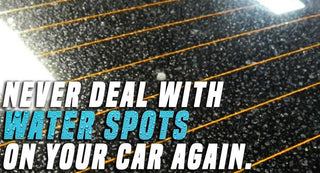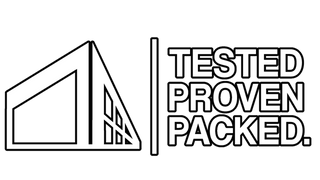
Your Guide to Water Spots
By Michael Mancha of Nucleus Auto Pros
A version of this blog was originally published on the website of Nucleus Auto Pros: https://www.nucleusautopros.com/post/definitive-guide-to-waterspots
"Water spots add character to your cars paint! As an added bonus they add an undeniable flare to your glass as well. I've heard it said that everything is subjective, perhaps there is someone out there that enjoys the look of water spots etched into their clearcoat? You know, like a face only a mother could love?"
-Absolutely no one
How do water spots happen?
In the auto detailing world, water spots are about as nightmarish as that neighborhood cat that likes to sharpen her claws on your trunk lid. Yikes! Sprinkler water, detailing in direct sunlight, & acid rain are usually the primary causes of etched in water spots. But why? Why is my freak'n water doing this to one of my most beloved investments? 3 letters: TDS.
When water is allowed to dry on a painted surface or glass the TDS's found in the water will stain your paint & glass. If not addressed immediately, a temporary water spot can turn into an etched in water spot that can only be corrected with a clay bar & D.A. buffer.
Whether you're a professional Auto Detailer or a DIY'er you've more then likely been personally acquainted with the supervillain known as "water spots", now get ready to learn about how to prevent them in the first place, how to remove fresh water spots, and how to remove etched in water spots
Fix #1: Avoid Water Spots with proper drying techniques
Of course, the easiest way to deal with water spots is to stop them from happening at all! Using proper drying methods will ensure that the waterborne TDS's never have a chance to sit on your car's exterior and become water spots. In addition to using several high quality drying towels like the Rag Company Dry Me a River, or the Microfiber Madness Chipmunk, you should be utilizing a drying aid every time you wash your car.
Using a Quick Detailer or a Spray Sealant as a drying aid is a very simple way to protect against water spots, and in certain cases, maintain and prolong the lifespan of a ceramic coating. Most spray waxes and sealants are very easy to use: simply mist one spray onto your drying towel, and one spray directly onto the surface of the car. Repeat with every new panel, and you ensure that you have a properly dried car that has hydrophobic protection, and won't develop water spots.
Another method to assure virtually no water spots is to use deionized water when washing your car. Deionized water in a nutshell is purified water that has had all of the minerals removed from it by being filtered through a special resin that removes all of the TDS's we talked about earlier. 100% deionized water will have a TDS level of 0 PPM. These systems can be costly but well worth the investment if you truly want to eliminate all chances of water spots. Deionized water can be left to dry & evaporate on any surface leaving no spots behind.
Fix #2: chemically neutralize fresh water spots before they etch into your clear coat
If a water spot is not yet etched into the surface of the clear coat, it may be neutralized and removed with acidic chemicals. While this may sound like a scary proposition for treating water spots on a protected car, there are several options from higher end chemical manufacturers that feature the power to neutralize water spots without damaging ceramic coatings, such as Gtechniq W9 Water Spot Remover, and Modesta M3 Fire. These water spot removers are a good place to start before pulling out your DA Buffer, because buffing out water spots will almost certainly also remove the coating, wax or sealant around the spot.
Fix #3: Buffing out water spots
But what if it's too late for preventive measures? If the damage has already been done don't fret, there are ways to deal with it. You'll need a D.A buffer: the Rupes shown above is top-of-the-line, but just about any buffer can achieve water spot removal. If that doesn't scare you away you will also need cutting/polishing pads along with compounds, polishes & possibly a specialty glass polish if your glass is in really bad shape.
Although buffing is an advanced topic in the auto detailing world, removing water spots is an easy enough task for just about anyone to accomplish, just remember there is always a risk of burning through your clearcoat & ending up in a worse situation then you started with, this is especially true if you don't have a paint meter to help you determine if it is safe to buff or not. With that being said always remember to start with the least aggressive pad & quality abrasives that you can get your hands on then progressively move up from there if you do not get the desired results.
In regards to removing defects from glass you want to bear in mind that although there is no clearcoat to burn through it can be warped if to much heat is concentrated in a certain area so always remember to check the temperature of the glass in between section passes. If you need more help for picking the right pad and glass polish, check out our video below:
Conclusion
As usual I hope you found this read entertaining & educational. If there is a question that was birthed from reading this article or if are local to us & you would like one of our pros to go take a look at your vehicle fill out this form. We are always happy to give advice and help out when we can.
Michael Mancha is the owner and operator of Nucleus Auto Pros in Houston, TX. To contact him and his team,
